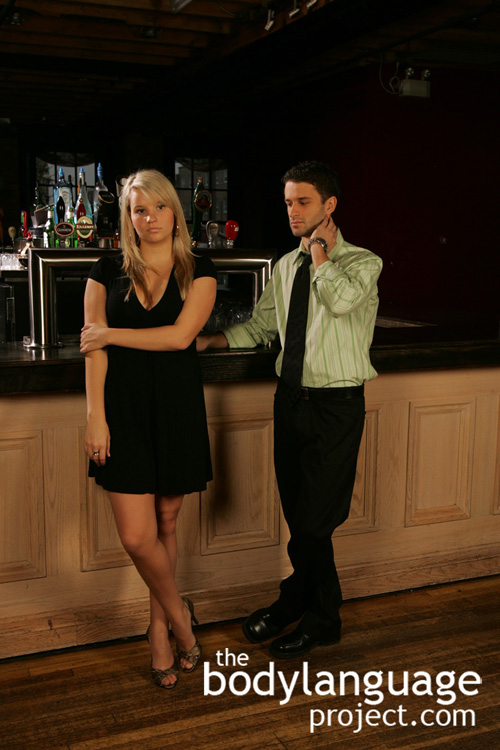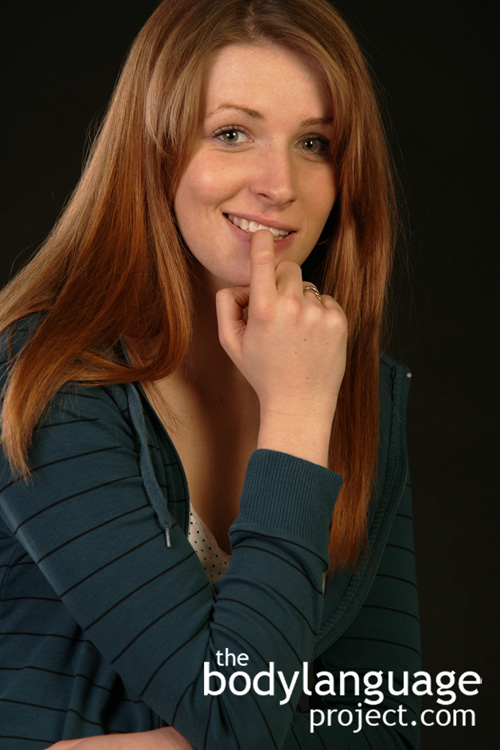Body Language of Slouching
Synonym(s): Body Sag.
Description: The head droops, shoulders hunch, feet are turned inward and the face often shows signs of depression or sadness.
In One Sentence: Slouching is a sign of social withdrawal and/or submission.
How To Use it: Slouching can be used to show dominance when used in the proper context. For example, when high status is already secured, slouching down backwards in a chair can boost the perception even further. Slouching, in the context, show that one is not at risk from a metaphorically attack and does not need to carry an engaged and ready body posture.
When a low ranking person slouches in full view of a higher ranking person, this can show willingness to defy authority. For example, should a rebellious teenager wish to instigate a confrontation, he or she simply needs to slouch as he or she engages in verbal combat. Slouching says, “I don’t care about your attempt at authority, I stand for my own ideas.”
Children can show their distain for the ideas of their parents by slouching forward in defeat. This plays on the emotions of their parents because they see that their decisions have created a sense of powerlessness. The parents, therefore, may think twice about continuing in eliciting submissiveness. Therefore, slouching can be used to manipulate more powerful people by nonverbally signaling defeat.
Context: General.
Verbal Translation: “I’m bored, disinterested, depressed or tired. As a result my body is going limp and losing its tone.”
Variant: N/A.
Cue In Action: a) He was a typical teenager, slouching in his chair without a care for authority. b) After a long day at work, the day-labourer slouched down on the sofa with a cold beer. c) He was going through a tough time in his life and he would often sag into a deep depression, slumped over with an expressionless face.
Meaning and/or Motivation: Taking on a relaxed position and postures when around others, such as slumping in your chair can be a way to increase your status. However, slouching independent of other dominant cues indicates submission – sometimes extreme submission to the world at large, especially when it is persistent across context. Slouching shows others that life gets us down and we have trouble coping with the difficulties it presents us. Slouching shows others an overall withdrawal.
Children often use slouching and pouting to show that they are upset and disappointed. Slouching also presents when people are bored or disinterested. People will be found slouching or sitting low in their seats perhaps awkwardly.
We should be careful about reading emotionally into slouching, because sometimes it just means someone is taking a break or is exhausted.
Cue Cluster: When slouching has emotional meaning, it is usually accompanied by fidgeting, putting hands in pockets, crossing arms, wringing the hands, talking with a hand hiding the mouth, and touching or scratching the face or neck without purpose, the eyes often are blank and the face is expressionless.
Body Language Category: Amplifier, Boredom body language, Comfort body language, Disengagement body language, Indicators of disinterest (IOD), Low confidence body language, Negative body language, Nonthreatening body language, Readiness to submit postures.
Resources:
Atkinson A, Dittrich W, Gemmell A, Young A. Emotion perception from dynamic and static body expressions in point-light and full-light displays. Perception 2004;33:717–46.
Aviezer H, Trope Y, Todorov A. Body cues, not facial expressions, discriminate between intense positive and negative emotions. Science 2012;338:1225–9.
Adams, E.S., Mesterton-Gibbons, M., 1995. The cost of threat displays and the stability of deceptive communication. J. Theor. Biol. 175, 405–421.
Boyson, A. R., Pryor, B., & Butler, J. (1999). Height as power in women. North American Journal of Psychology, 1, 109–114.
Burgoon, J. K., & Hoobler, G. (2002). Nonverbal signals. In M. L. Knapp & J. A. Daly (Eds.), Handbook of interpersonal communication (3rd ed., pp. 240–299). Thousand Oaks, CA: Sage.
Burgoon, J. K., Johnson, M. L., & Koch, P. T. (1998). The nature and measurement of interpersonal dominance. Communication Monographs, 65, 308–335.
Bohns, Vanessa K. and Scott S. Wiltermuth. It Hurts When I Do This (Or You Do That): Posture And Pain tolerance. Journal of Experimental Social Psychology. 2012. 48: 341-345. http://bodylanguageproject.com/articles/dominant-and-submissive-postures-affects-more-than-public-perception-it-also-affects-felt-pain-and-physical-strength/
Bartlett Marian S, Littlewort Gwen C, Frank Mark G, Lee K. Automatic decoding of facial movements reveals deceptive pain expressions. Curr Biol 2014;24:738–43.
Boucher J, Carlson G. Recognition of facial expression in three cultures. J Cross Cult Psychol 1980;11:263–80.
Bertamini, Marco ; Byrne, Christopher ; Bennett, Kate M. Attractiveness is influenced by the relationship between postures of the viewer and the viewed person. i-Perception. 2013. 4(3): 170-179.
Cashdan, Elizabeth. Smiles, Speech, and Body Posture: How Women and Men Display Sociometric Status and Power. Journal of Nonverbal Behavior. 1998. 22(4): 209-228.
Coulson M. Attributing emotion to static body postures: recognition accuracy, confusions, and viewpoint dependence. J Nonverbal Behav 2004;28:117–39.
Carney, D. R., Hall, J. A., & LeBeau, L. S. (2005). Beliefs about the nonverbal expression of social power. Journal of Nonverbal Behavior, 29, 105–123.
Dijkstra, Katinka; Michael P. Kaschak; and Rolf A. Zwaan. Body Posture Facilitates Retrieval of Autobiographical Memories. Cognition. 2007; 102: 139-149. http://bodylanguageproject.com/articles/improve-recall-match-posture-memory-study/
Ellis, L. (1994). The high and the mighty among man and beast: How universal is the relationship between height (or body size) and social status? In L. Ellis (Ed.). Social stratification and socioeconomic inequality (Vol. 2, pp. 93–111). Westport, CT: Praeger Publishers.
Flack, William F., Jr. Peripheral Feedback Effects of Facial Expressions, Bodily Postures, and Vocal Expressions on Emotional Feelings. Cognition and Emotion. 2006. 20 (2), 177-195. DOI:10.1080/02699930500359617
http://bodylanguageproject.com/articles/body-and-facial-expressions-influence-mood/
Girard, Jeffrey M.; Jeffrey F. Cohna; Mohammad H.Mahoor S.; Mohammad Mavadati;
Zakia Hammal; and Dean P. Rosenwalda. Nonverbal Social Withdrawal In Depression: Evidence From Manual And Automatic Analyses. Image and Vision Computing. 2013.
http://bodylanguageproject.com/articles/body-language-signals-withdrawal-depression
Glenn E. Weisfeld and Jody M. Beresford. 1982. Erectness of posture as an indicator of dominance or success in humans. Motivation and Emotion. 6(2):113 -131.
Geisser M, Robinson M, Keefe F, Weiner M. Catastrophizing, depression and the sensory, affective and evaluative aspects of chronic pain. PAIN. 1994;59:79–83.
Hall, Judith ; LeBeau, Lavonia ; Reinoso, Jeannette ; Thayer, Frank. Status, Gender, and Nonverbal Behavior in Candid and Posed Photographs: A Study of Conversations Between University Employees. Sex Roles. 2001 44(11): 677-692.
Keogh E. Gender differences in the nonverbal communication of pain: A new direction for sex, gender, and pain research? PAIN_ 2014;155:1927–31.
Kret M, Pichon S, Grezes J, de Gelder B. Similarities and differences in perceiving threat from dynamic faces and bodies. An fMRI study. NeuroImage 2011;54:1755–62.
Katza, Carmit; Irit Hershkowitz; Lindsay C. Malloya; Michael E. Lamba; Armita Atabakia and Sabine Spindlera. Non-Verbal Behavior of Children Who Disclose or do not Disclose Child Abuse in Investigative Interviews. Child Abuse & Neglect. 2012. 36: 12-20.
http://bodylanguageproject.com/articles/reading-nonverbal-behaviour-child-abuse-cases-encourage-children-divulge-information-truth-telling/
Li Huang, Adam D. Galinsky, Deborah H Gruenfeld and Lucia E. Guillory. Powerful Postures Versus Powerful Roles: Which Is the Proximate Correlate of Thought and Behavior? 2011, Psychological Science; 22(1): 95–102.
http://bodylanguageproject.com/articles/whats-more-powerful-nonverbal-power-or-real-power/
LaFrance, Marianne. and W. Ickes. 1981. Posture mirroring and interactional involvement: sex and sex typing effects. Journal of Nonverbal Behavior 5: 139-154.
Marsh, Abigail A; Henry H. Yu; Julia C. Schechter and R. J. R. Blair. Larger than Life: Humans’ Nonverbal Status Cues Alter Perceived Size. PLoS ONE. 2009. 4(5): e5707. doi:10.1371/journal.pone.0005707. http://bodylanguageproject.com/articles/large-life-nonverbal-dominance-affects-perception-size/
Michalak, Johannes, Judith Mischnat and Tobias Teismann. Sitting Posture Makes a Difference—Embodiment Effects on Depressive Memory Bias. Clinical Psychology and Psychotherapy. 2014. 21, 519-524. DOI: 10.1002/cpp.1890
http://bodylanguageproject.com/articles/sit-can-embody-depression-body-language-postures-control-mental-processes/
Michalak, J., Troje, N. F., Fischer, J., Vollmar, P., Heidenreich, T., and Schulte, D. Embodiment of sadness and depression— Gait patterns associated with dysphoric mood. Psychosomatic Medicine. 2009. 71, 580–587.
McGrath P, Johnson G, Goodman J, Schillinger J, Dunn J, Chapman J. CHEOPS—a behavioral-scale for rating postoperative pain in children. Adv Pain Res Ther 1985;9:395–402.
Meier, B. P., Hauser, D. J., Robinson, M. D., Friesen, C. K., & Schjeldahl, K. (2007b). What’s ‘up’ with God?: Vertical space as a representation of the divine. Journal of Personality and Social Psychology, 93, 699–710.
Meier, B. P., & Robinson, M. D. (2004). Why the sunny side is up: Associations between affect and vertical position. Psychological Science, 15, 243–247.
Meier, B. P., & Robinson, M. D. (2005). The metaphorical representation of affect. Metaphor and Symbol, 21, 239–257.
Melamed, T. (1992). Personality correlates of physical height. Personality and Individual Differences, 13, 1349–1350.
Middleton, W. C., &Moffett, D. C. (1940). The relation of height and weight measurements to intelligence and to dominance-submission among a group of college freshmen. Research Quarterly of the American Association for Health, Physical Education, and Recreation, 11, 53–59.
Montepare, J. M. (1995). The impact of variations in height on young children’s impressions of men and women. Journal of Nonverbal Behavior, 19, 31–47.
Meier, B.P., Robinson, M.D., & Caven, A.J. (in press). Why a big mac is a good mac: Associations between affect and size. Basic and Applied Social Psychology.
Matsumura, Shuichi ; Hayden, Thomas J. When should signals of submission be given?–A game theory model. Journal of Theoretical Biology. 2006. 240(3): 425-433.
Mehrabian, Albert Holzberg, Jules D. (editor). Inference of Attitudes From the Posture, Orientation and Distance of a Communicator. Journal of Consulting and Clinical Psychology. 1968. 32(3): 296-308.
Mehrabian, Albert Deese, James (editor). Significance of posture and position in the communication of attitude and status relationships. Psychological Bulletin. 1969. 71(5): 359-372.
Matsumoto, D., & Willingham, B. (2006). The thrill of victory and the agony of defeat: Spontaneous expressions of medal winners of the 2004 Athens Olympic Games. Journal of Personality and Social Psychology, 91(3), 568–581.
Mouterde, S. C., Duganzich, D. M., Molles, L. E., Helps, S., Helps, R., & Waas, J. R. (2012). Triumph displays inform eavesdropping little blue penguins of new dominance asymmetries. Animal Behaviour, 83, 605–611.
Mondloch, Catherine J. Sad or Fearful? The Influence of Body Posture on Adults’ and Children’s Perception of Facial Displays of Emotion. Journal of Experimental Child Psychology. 2012. 111(2): 180-196.
Oosterwijk, S., Rotteveel, M., Fischer, A. H., & Hess, U. Embodied emotion concepts: How generating words about pride and disappointment influences posture. European Journal of Social Psychology. 2009. 39, 457–466.
Oosterwijk, Suzanne; Mark Rotteveel; Agneta H. Fischer and Ursula Hess. Embodied Emotion Concepts: How Generating Words About Pride and Disappointment Influences Posture. European Journal of Social Psychology. 2009. 39: 457–466. DOI: 10.1002/ejsp.584
http://bodylanguageproject.com/articles/embodiment-nonverbal-posture-thinking-pride-shame-literally-changes-body-language/
Prieto, A. G., & Robbins, M. C. (1975). Perceptions of height and self-esteem. Perceptual and Motor Skills, 40, 395–398.
Pablo Briñol; Richard E. Petty and Benjamin Wagner. Body Posture Effects on Self-Evaluation: A Self-Validation Approach. European Journal of Social Psychology. 2009. 39(6): 1099-0992. DOI: 10.1002/ejsp.607. http://dx.doi.org/10.1002/ejsp.607
http://bodylanguageproject.com/articles/fix-posture-fix-confidence/
Riskind, J. H. Nonverbal Expressions and the Accessibility of Life Experience Memories: A Congruence Hypothesis. Social Cognition. 1983. 2: 62-86.
Rand, G., and Wapner, S. Postural Status as a Factor in Memory. Journal of Verbal Learning and Verbal Behavior. 1967. 6: 268-271.
Rule, Nicholas, O.; Reginald B. Adams Jr.; Nalini Ambady and Jonathan B. Freeman. Perceptions Of Dominance Following Glimpses Of Faces And Bodies. Perception. 2012; 41: 687-706 doi:10.1068/p7023
http://bodylanguageproject.com/articles/people-can-read-dominance-split-second
Robinson, Michael D. ; Zabelina, Darya L. ; Ode, Scott ; Moeller, Sara K. The vertical nature of dominance-submission: Individual differences in vertical attention. Journal of Research in Personality. 2008. 42(4): 933-948.
Simon D, Craig K, Gosselin F, Belin P, Rainville P. Recognition and discrimination of prototypical dynamic expressions of pain and emotions. PAIN_ 2008;135:55–64.
Schubert, T. W. (2005). Your highness: Vertical positions as perceptual symbols of power. Journal of Personality and Social Psychology, 89, 1–21.
Schwartz, B., Tesser, A., & Powell, E. (1982). Dominance cues in nonverbal behavior. Social Psychology Quarterly, 45, 114–120.
Stepper, S., & Strack, F. (1993). Proprioceptive determinants of emotional and nonemotional feelings. Journal of Personality and Social Psychology, 64, 211–220.
Schenkel, Rudolf. Submission: Its Features and Function in the Wolf and Dog. American Zoologist. 1967. 7(2): 319-329.
Scarpa, Stephano; Alessandra Nart; Erica Gobbi and Atillo Carraro. Does Women’s Attitudinal State Body Image Improve After One Session Of Posture Correction Exercises? Social Behavior and Personality. 2011; 39(8): 1045-1052.
Sturman, Edward D. Invluntary Subordination and Its Relation to Personality, Mood,
and Submissive Behavior. Psychological Assessment. 2011. 23(1): 262-276 DOI: 10.1037/a0021499
http://bodylanguageproject.com/articles/nonverbal-submission-men-women-depression-critical-examination-use-disuse-submission/
Tomei, Alexander and Jeremy Grivel. Body Posture and the Feeling of Social Closeness: An Exploratory Study in a Naturalistic Setting. Current Psychology. 2014. 33:35–46
DOI 10.1007/s12144-013-9194-1
http://bodylanguageproject.com/articles/stand-increase-feelings-closeness-use-body-posture-influence-perception/
Tiedens, Larissa Z ; Fragale, Alison R. Power moves: complementarity in dominant and submissive nonverbal behavior. Journal of personality and social psychology. 2003. 84(3): 558-68.
Tracy, J. L., & Robins, R. W. (2004). Show your pride: Evidence for a discrete emotion expression. Psychological Science, 15, 194–197
Weisfeld, Glenn E. and Jody M. Beresford. Erectness of Posture as an Indicator of Dominance or Success in Humans. Motivation and Emotion. 1982. 6(2): 113-130.
http://bodylanguageproject.com/articles/body-language-cues-dominance-submission-children/
Tracy, J. L., & Matsumoto, D. (2008). The spontaneous expression of pride and shame: Evidence for biologically innate nonverbal displays. Proceedings from the National Academy of Sciences, 105(33), 11655–11660.
Tracy, J. L., & Robins, R. W. (2007). The prototypical pride expression: Development of a nonverbal behavior coding system. Emotion, 7(4), 789–801.
Welker, Keith M. ; Oberleitner, David E. ; Cain, Samantha ; Carré, Justin M. Upright and left out: Posture moderates the effects of social exclusion on mood and threats to basic needs. European Journal of Social Psychology. 2013 43(5): 355-361.
Walsh, Joseph ; Eccleston, Christopher ; Keogh, Edmund. Pain communication through body posture: The development and validation of a stimulus set. Pain. 2014. 155(11): pp.2282-2290







